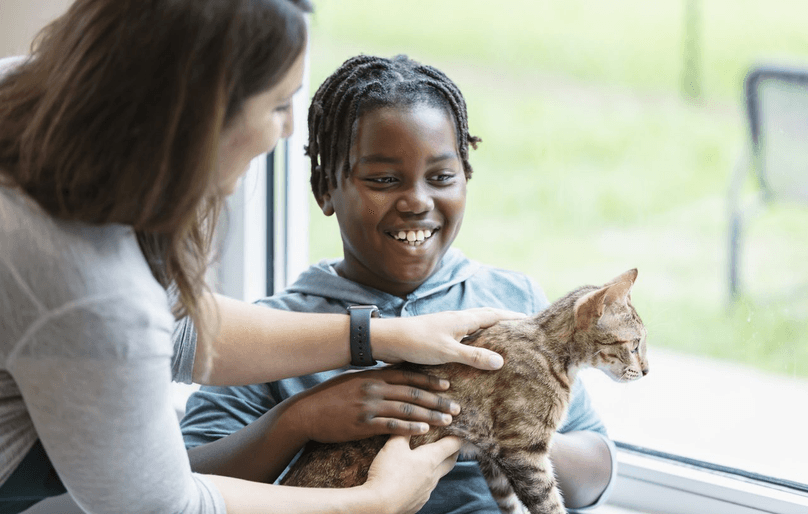
Animal shelters are often overcrowded, and with resources limited, euthanasia has become an unfortunate reality for many pets. Each day in America, between 4000 and 10,000 shelter animals are euthanized. Sadly, many of these animals are healthy and adoptable.
June is designated Adopt A Shelter Cat Month, a time to raise awareness of the shelter and euthanasia crisis and to encourage pet adoptions nationwide. Thinking of adopting a shelter cat? You’ll be giving a forever home to an animal in need, and helping to ease the burden on already overextended shelters. Here are some tips to get you started.
What to Ask When You Visit the Shelter
Adopting a new pet is a commitment and a responsibility. So you’ll probably want to have a list of questions to ask the shelter staff before finalizing any adoption. Here are a few examples:
- What is the cat’s medical history? When inquiring about a pet’s overall health, spay/neuter history, vaccinations, etc., it’s a good idea to get a medical history. This will let you know what tests or procedures the animal has had, and what care needs it’s likely to have in the future.
- Is the cat litter trained? While many adult cats have lived with humans and are litter trained, others are feral and have yet to learn their house manners. The answer to this question will help you know just how much training your new cat will require.
- Is the cat good with pets/kids? Knowing a bit about a cat’s personality can help you choose the right animal for you. If you have other pets or children in the home, you may want to select an adaptable cat with a calm disposition.
- Does the cat have any special needs? Even healthy cats can have special needs. A food allergy or a prior injury could change the way you care for your new pet, so it’s always a good idea to ask.
Bringing Your Cat Home: What You’ll Need
Before you bring your new cat home, you’ll want to do a little prep work. Here are a few of the basics to have on hand:
- A safe, quiet space. Be sure to create a space where your cat can hide if it feels overstimulated.
- A comfy blanket or cat bed. Choose a cat bed that gives them a place to feel cozy and warm.
- Food and water bowls. Your new arrival should have its own food and water containers even if you have other pets.
- A litter pan, scoop, and litter. The pan should be sized so that the cat can easily step in and out. There are many designs and styles, including self-cleaning pans, so choose the one that best fits your needs (and your budget).
- Cat toys. Toys can provide hours of amusement and reduce the chances that your new kitty will damage property.
Introducing Your New Cat to Other Cats
If you already have other cats in the home, introducing a new arrival can be stressful. Here are a few steps you can take to make the process go more smoothly.:
- Isolate the new pet in a spare room if possible. This will let your cats check out the new arrival by scent before meeting face to face.
- Give the new cat its own food and litter. If your cats share food bowls or litter pans, that’s okay, but in the acquaintance stage it’s best to let your new adoptee have its own.
- Be patient. Cats are curious creatures and will likely want to know more about each other. When you introduce the new arrival, try to select a place where no animal feels a territorial advantage. And be sure the new cat is free to hide if the first meeting doesn’t go as planned.
Editor’s Note:If you’re introducing your shelter kitty to a dog, here are tips to make that transition smoother.
Introducing Your Cat to Children
If you have young children, preparing them for a new pet begins with a discussion. Talk to your kids about the cat, and what it’ll need when it arrives. Make your expectations about your children’s behavior clear and your instructions simple.
- Teach your kids about how your new cat might react. (ex. hissing is an involuntary fear response)
- Remind them that cats are sensitive to sound and movement and to avoid loud noises or sudden movements.
- Give your child and pet space to meet—and be sure your cat has a place to hide if it feels overwhelmed.
- Be gentle and patient: First encounters between kids and pets go best when everyone is calm and open. Even timid or aggressive cats often become affectionate cuddlers once they’ve acclimated to their new home.
- Show your children how to hold a cat—and once you’ve gotten past the introductions, show your child how to approach, pet, and hold a cat.
Older Cats in Shelters
Studies have found that 7 of 10 cats that enter the shelter system are euthanized, with a large number being senior animals and unweaned kittens. Senior pets whose owners can no longer care for them often find themselves in a special predicament—while many senior cats surrendered to shelters are healthy, they are also the most commonly euthanized.
Opening your home to a senior pet has advantages that many people overlook:
- Senior cats are litter trained
- Senior cats acclimate quickly
- Senior cats are typically less destructive than kittens
- Senior cats are great cuddlers
When you visit the shelter, check out the older animals available for adoption. One could be your next best friend.
Conclusion
We hope these tips help you find the right pet for you. Want to promote Adopt a Shelter Cat Month? Share your cat adoption story on social media! Your success story can encourage others to adopt, thus reducing pressure on already overburdened animal shelters.